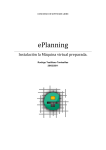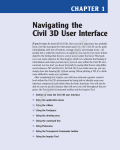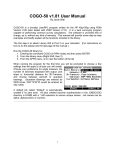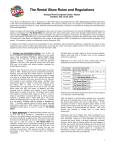Download E-Planning User Guide
Transcript
ePlanning Scotland User Guide The ePlanning Scotland website has been designed by the Scottish Government to provide an efficient and supportive process for members of the public and professional services (such as architects and agents) to apply for planning permission or appeal against refused consent or against conditions applied when consent is granted. The online process provides easy-to-use forms to allow you to submit planning applications and appeals online and assist you in submitting the relevant form, documentation and correct fee. This guide describe how to use the site. ePlanning Scotland User Guide / Version 2.0 / July 2009 1 Contents User Guide ..................................................................................................................................1 Create A User Account .................................................................................................................3 Login .............................................................................................................................................5 My Account ...................................................................................................................................7 Sharing........................................................................................................................................10 Proposals ....................................................................................................................................17 My Proposals ..............................................................................................................................18 Creating a Proposal ....................................................................................................................19 Completing a Proposal................................................................................................................29 2 Create A User Account Before you can use the ePlanning Scotland site to manage planning applications and appeals, you must first create a user account. 1. To create a new user account click on the Create an Account button on the Home page. 2. Register your personal details by filling in the following fields: • User Type – click to indicate whether you are a member of the public or a member of a professional organisation • Title – select the title you wish to be addressed by • First Name – enter your first name • Surname – enter your surname. 3 3. Your login details are the particulars that you will use to access ePlanning Scotland. • Email Address – enter your email address. Enter it again below to confirm that it is correct. • Password – enter a password that will allow only you to access your ePlanning Scotland account. Note Passwords must be a minimum of five characters long and may not contain spaces. Enter the password again below to confirm that it is correct. 4. Click to read the Terms and Conditions that apply to the use of this site. When you have done so tick the check box to indicate that you agree to them. 5. When you have entered your personal and login details, click on the Save Account Details button. 6. An email will be sent to the address you entered. This provides final confirmation that you want to create an ePlanning Scotland account. When the email arrives, click on the link to be returned to the ePlanning Scotland site. 7. Your account is now complete and you may log in and start using it. 4 Login In order to use ePlanning Scotland you need to log in to the site using the user name and password you provided when you created your account. 1. Click on the Login button on the home page. 2. Enter your user name and password, then click on the Login button. Timeout After a period of inactivity (typically 30 minutes), your session will automatically be logged out. In order to continue working you must log in again. Once you have done that you will be returned to your My Proposals page. 5 Forgotten Password 1. If you forget your password click on the Forgotten password? link. 2. Enter your email address and then enter a new password twice. Press the Save button. 3. A confirmation email will be sent to your email address. When it arrives, click on the confirmation link. You will now be able to log in with your new password. Logout When you are finished with ePlanning Scotland remember to log out by clicking on the Logout button in the menu bar on the left hand side of the screen. 6 My Account Once your account has been created it is a good idea to add further details, such as your address, which can be incorporated in your applications. The My Account page can be accessed at any time to allow you to update any of your account details. 1. To access your My Account page click on My Account in the left hand menu bar. 2. Your Personal Details and Login Details will be filled in already, but you can edit these at any time. 7 3. 4. Fill in your Contact Details, including: • Company name • Phone number • Fax number • Full Address, including postcode. When you have finished, click on the Save Account Details button. Change Password 1. To update your password, click on the Change Password link in your My Account page. 2. Enter your new password then enter it again to confirm it. Click on the Change Password button to save the new password. 3. A confirmation email will be sent to your email address. When it arrives, click on the confirmation link. You will now be able to log in with your new password. 8 Unregister If you no longer wish to use ePlanning Scotland you can remove your details by Unregistering. Note that Organisation Administrators must first transfer administrator rights to another user or delete the organisation before they can unregister their details. 1. To unregister your details, click on the Unregister link in your My Account page. 2. Confirm that you want to remove your details from ePlanning Scotland by entering your password in the Confirm Password box. 3. Click on the Confirm button. 9 Sharing It is often helpful to involve other people in your proposals to receive their opinions and help. The advice of architects and planning professionals can be invaluable, while neighbours may appreciate being able to view your plans while the planning process is ongoing. You can invite other people to become ePlanning Scotland users and allow them either to view or edit your proposals, and other users can offer you the same invitation. Professional users can create collaborative groups of users from their organisation who are automatically awarded the ability to view proposals created by other members. Receiving a Sharing Invitation When someone sends you an invitation to view an application, you will be sent an email informing you of this. 1. Log in to ePlanning Scotland. 2. You will be asked if you want to accept or decline the invitation. Click on Accept. 10 Issuing a Sharing Invitation Once you have created a proposal you can invite others to view it by going to the Proposal Users section in the Proposal Summary page. You may invite as many users as you like. 1. On the Proposal Summary page click on Send Invitation. 2. Enter the name of the person you want to invite and then enter their email address. 3. Type a short note in the Message box to explain the purpose of the invitation. 4. Select the role that you want this user to have by selecting Viewer or Editor for User Role. 5. Click on the Invite button. 11 Modify Proposal Users Once you have invited people to view your application they will be entered into the proposal’s Users Invited to Share area until they either accept or decline the invitation. The number of pending invitations is displayed in the Proposal Users area of the Proposal Summary. You can modify the viewing rights for users who accept the invitation, and allow some of them to edit your proposal if required. 1. Click on Modify Proposal Users on the Proposal Summary page. 2. To change a user’s rights from Viewing to Editing, select them and press Set as Editor. 3. To change a user’s rights from Editing to Viewing, select them and press Set as Viewer. 4. To delete a user’s ability to view your proposal, select them and press Remove User. 5. Users Invited to Share lists the users to whom you have sent an invitation but have not yet accepted or declined. You can send a user a reminder email by selecting them in this section and clicking on the Send Reminder button. Alternatively, to withdraw the invitation, select the user and click on the Cancel Invitation button. 12 6. If you are a member of an organisation, your proposals will be accessible by all of your organisation’s members. These users will have one of the following roles: 7. • Primary Contact – the main user involved in the proposal. Only the Primary Contact can administer the user roles for this proposal. If you created the proposal, this will be you unless you make another user the Primary Contact. • Editor – a user who can work on the proposal, editing the proposal details and completing the attached forms. • Viewer – a user who is not directly involved in completing the proposal but is allowed to view the proposal for information purposes only. To make another member of your organisation the Primary Contact, select them and click on the Set as Primary Contact button. Note When you transfer Primary Contact status to another user you will automatically lose the ability to modify the user status of that proposal unless you’re the administrator of the organisation. 8. To allow a member of your organisation to edit the details of the proposal, select them and click on Set as Editor. 9. To restrict a member of your organisation to viewing this proposal, select them and click on Set as Viewer. 13 Organisations Professional users can create groups of users, known as Organisations. Organisations are used to allow members to collaborate on the proposals created by their colleagues. Generally these correspond to a business organisation or coalition of individuals who often work together. Note Users can only belong to ONE organisation. 1. To register an organisation on ePlanning Scotland, click on Sharing in the left hand menu then click on Register a new organisation on the Sharing page. 2. Enter a name for the organisation then click on the Register Organisation button. 3. Enter the name of the person you want to invite to join the organisation, then enter their email address. 4. Type a short note in the Message box to explain the purpose of the invitation. 5. Click on the Invite button. 6. Users who have not yet accepted or declined the invitation are listed under Invitations Already Sent. Those who choose to join the organisation will disappear from this list. 14 Joining an Organisation If you are invited to join an organisation, you will be notified by email. You can accept or decline the invitation. Once you have accepted the invitation the organisation’s details will be shown in your Sharing page and all of the proposals that belong to the members of the organisation will be available in your My Proposals page. Notes • You cannot remove yourself from an organisation. Only the organisation’s administrator can do that. • If the organisation is deleted, all users that belong to it (except the administrator) will lose access to the proposals. Managing Organisations When you create an organisation you are automatically made the organisation’s administrator. This allows you to invite further users, remove existing users, or transfer the administrator role to another user. 1. To invite another member to the organisation, click on Invite Member and enter the name, email address and invitation message. Then press Invite. 2. To remove a user from the organisation, click on the Remove button next to their name. 3. To transfer administrator rights to another organisation member, click on Set as Admin next to their name. 15 4. Pending Organisation Invitations lists the users to whom you have sent an organisation invitation but have not yet accepted or declined. You can send a user a reminder email by clicking on Send Reminder as appropriate. Alternatively, to withdraw the invitation, click on the Remove button. 5. If the organisation is no longer required, you can delete it by clicking on Delete Organisation. When you delete an organisation you will also be given the option of deleting the user accounts of the organisation’s members. If you delete the user accounts, the proposals that were shared by the organisation become the sole property of the administrator. If you do not take this option, the proposals revert to their original owners. 16 Proposals The core purpose of ePlanning Scotland is to help you create, manage and submit planning applications and appeals. All of this is done in your My Proposals area. A proposal comprises a number of activities. Your My Proposals area provides a number of tools to help you to work out which activities you need to complete and allows you to keep track of their status until your proposal is ready for submission. Proposal Activities The following activities may be required to be completed in order to complete your proposal: • Planning permission required? - determine whether your proposal requires planning permission • Determine proposal location – choose which address or location the proposal refers to • Complete appropriate forms – determine which forms are required for your proposal and fill them in • Attach location plans – determine whether location plans are required. If you do not already have access to location plans they can be published via ePlanning Scotland • Submit certificates – sign and submit any required certificates • Pay fees – work out which fees are applicable and pay the total amount. As your proposals remain active until they are submitted, you can perform these activities at different times until a proposal is ready to submit. 17 My Proposals Your My Proposals list displays all of the proposals in which you have some involvement. 1. Under Show Proposals, click on All to display all of the proposals available to you. These will include your own proposals, as well as proposals that you have been invited to contribute to, either as a viewer or an editor. 2. Click on I manage to display only the proposals for which you are the primary contact. 3. Click on I can edit to display the proposals you have been allowed to contribute to as an editor. You can sort the listed proposals according to a number of criteria: • Proposal Name – sort alphabetically by the name of the proposals • Planning Authority – sort alphabetically by the planning authority • Primary Contact – sort alphabetically by primary contact • Proposal Reference – sort by the proposal reference • Date Started – sort chronologically by the date your proposals were initiated (this only applies to proposals of which you are the owner). Active proposals are proposals currently in progress. When a proposal has been completed and submitted you can delete it. Proposals deleted during the last 90 days can be viewed in the Deleted area. 18 Creating a Proposal 1. To create a new proposal click on New Proposal in the My Proposals page. 2. Identify the location of the proposal site. There are three methods of doing this: • Address Search – the address of the property • Easting and Northing – the easting/northing references of the proposal location • Map Search – an interactive map used to locate a property whose exact address is not known. Proposal Location Address Search If the proposal location is a building with a known or partially known address you can enter that here. 1. Enter at least two pieces of information into the address search fields then click on the Address Search tab. 2. If the proposal location is your own address (the address you supplied in your My Account page), you can search quickly using your Postcode. Click on the Use My 19 Postcode button to fill the address fields, then click on Postcode Search. You can also use this field to search on any other known Postcode. 3. If the proposal location is at another address, enter the known address details in the appropriate Address fields. You don’t have to enter information in every field, but the more information you supply the easier it will be to locate the correct address. 4. Click the Address Search button to display the search results list. 5. Locate the correct location in the list. If necessary sort the list according to the Address, the Town or the Postcode by clicking on the links at the top of the list. 6. If there are numerous results you can choose how many to display on one page by clicking on a Page Size button. Navigate between pages by clicking on the Results Page number you require. 7. When you have found the correct location click on its name. 8. Review the details then click on the Confirm Address button (now see Confirm Planning Authority). Note If you discover a minor error in your address details, it is recommended that you complete your proposal and then email your planning authority to report the error. 9. If there are too many results in the list, click on the Refine Search button to return to the Address Search page and enter more information. 10. If you cannot find a match, click on the No Exact Match button. If you have a broadband connection, you can select I can use the non-accessible mapping tool to use the interactive map tool to determine the location (see Map Search). Click on Continue. 11. Otherwise select I cannot use the non-accessible mapping tool and click on Continue. This allows you to contact your planning authority to obtain location information that you can use in your proposal. 20 12. To contact your planning authority select Not Yet and click on Continue. Select the appropriate planning authority and use the contact details to request the information you need. Either click on the Return Later button to exit the proposal so that you can resume it when you have the information, or if you get the information immediately click on the Previous button and continue. 13. When you have the information you need, you can return to this page, click on Yes and enter the information you have been given. Click on Use as Site Location, then click on Confirm Address (now see Confirm Planning Authority). 21 Easting and Northing Search Eastings and Northings are map references that can be used to point to a precise location. This search method is useful when you want to specify a proposal location that does not currently have an address (for example, a plot of land). 1. If the Easting and Northing Search fields are not displayed, click on the Easting and Northing search tab. 2. Enter the Easting value (between 0 and 500000) in the Easting box. 3. Enter the Northing value (between 500000 and 1300000) in the Northing box. 4. To use these references to define the proposal location, click on Save. 5. Click on the Confirm Address button (now see Confirm Planning Authority). 6. To check that these references define the correct location, you can view it on the interactive map. Click on the Use Map button (see Map Search). 22 Map Search If you area of interest to the proposal is on open land you can use the Map Search feature to identify the location using an interactive map. Note This feature is only recommended for broadband users. 1. If the interactive map is not displayed, click on the Map Search tab. 2. The interactive map contains a number of tools to help you zoom in and locate the desired address: • Initial map view – click this to zoom the map out to show the whole of Scotland • Zoom in – select this tool then click a point on the map that you want to zoom in to • Zoom out – select this tool then click on the map to zoom out • Pan mode – to move around the map, select this then click on the map. Keeping the mouse button depressed, drag the cursor in the direction that you want to pan • Zoom to rectangle – to zoom in on a selected area, select this tool then click and drag the cursor to draw an area on the map • Previous view – to return to the previous view, click on this tool 23 • Next view – when you have used the Previous view tool, click on this button to go to the view that followed the one that is currently displayed • Select address – to identify a location on the map that you want to use for the proposal location, select this tool and click on the desired point on the map. If you click on a building, the address will be displayed. If you click anywhere else, only the easting and northing reference will be displayed. • Eastings/ Northings reference – displays the easting and northing reference of the place on the map that the cursor is currently pointing at • Map area – displays the dimensions of the area displayed by the map. 3. Use these tools to locate the correct property. Click on the Select Point Location for Proposal button, then click on the map to identify the property. 4. To use the exact easting/northing reference as the proposal location click on Use this point as site location. 5. Click on Confirm Address. 24 Confirm Planning Authority Once you have selected the proposal location, the appropriate planning authority will be displayed. 1. Check the planning authority that is suggested. 2. If this is correct click on the Next button. 3. If it is not correct please contact the relevant authority directly. The authority contact details can be accessed by clicking on Authority Contact Details. Name Proposal The proposal now needs to be named and given a short description. 1. Enter a name for the proposal in the Proposal Name box. 2. Briefly describe the proposal in the Proposal Details box. 3. Click on Confirm Details. 25 Select Forms At this stage you can select which forms will need to be completed and submitted along with the application. You do not have to do this at this stage, but you may find it easier if you do. 1. From the options provided, choose one of the following and press Select. 2. Select forms using a wizard – this is recommended if you are unsure about the planning process. The ‘Which Form?’ Wizard leads you through a number of questions related to the nature of your proposal. Once you have answered the questions on each page, the wizard will recommend one or more forms to be completed with your application or appeal. Note The ‘Which Form?’ Wizard selects only required forms. It does not offer forms that might be suggested as possible or optional. The ‘Which Form?’ Wizard can be accessed at any time by clicking on the ‘Which Form?’ Wizard link in the left hand menu bar. If you have already used the ‘Which Form?’ Wizard for this application the required forms will be pre-selected. 26 3. Select forms from a list – if you are a little more experienced with the planning process and know which forms will be required you can select the forms appropriate to your application directly. Once you have selected the correct forms, click on the Add Forms button. 4. Create proposal without forms – instead of adding the forms now you can choose to skip this step. The forms can be added later or copied from a previously created proposal by selecting this option. 27 Create Proposal The final step in creating your proposal is to check the proposal summary and enter the proposal into your My Proposals area. 1. Read carefully through the proposal summary and the list of selected forms and make sure that these are accurate. 2. If you need to make any changes, click the Previous button and step back through the process to the step that needs amendment. 3. When you are happy that the proposal details are correct, click on the Create Proposal button. 28 Completing a Proposal In My Proposals, click on a proposal name to view its Proposal Summary. In this area you can: • Complete the application Forms you selected when the proposal was created • Add new forms or copy existing ones • Review forms that have already been Submitted. • Edit the Proposal details • Edit the proposal Site location • Invite people to view the proposal and manage their roles (see Sharing) • Contact the relevant Planning or Appeals Authority. 29 Completing an Application In order to submit your proposal you need to complete all of the relevant application forms. This process may include completing the individual forms, providing supporting material such as location plans, submitting certificates, and paying fees. Application Forms Incomplete application forms are listed in the Draft Forms section of the Proposal Summary page. You can delete any Draft Form by clicking on the Delete button. Forms which have been completed and are listed in the Submitted Forms area. Submitted forms are retained for up to 90 days during which you can or refer to them for information or copy them for use in other applications. 90 days after a form has been submitted it will be deleted from your application. 30 Completing a Form 1. In the Draft Forms area of the Proposal Summary click on the name of the application to access the Application Summary page. 2. Each element required by the application has a status displayed. You need to complete each element and turn all of the status indicators to ticks. Remember that you do not have to complete an application all at once, you can log out and return to complete more of it at a later time. 31 Location Plan The Location Plan is a required part of your application, because it indicates clearly the property that is the subject of the proposal. ePlanning Scotland offers you the choice of: • Purchasing and marking up the plan online • Attaching an existing plan and submitting it either by online upload or post. 1. Click on Location Plan in the Proposal Summary. 2. Select whether to Purchase the plan online or Attach an existing one. 32 Purchase Location Plan 1. If you are an inexperienced user it is recommended that you purchase a location plan via ePlanning Scotland, mark it up with the relevant information and attach it to your application. To do this, select Purchase Location Plan, then click on Continue. Note This opens the interactive mapping tool. (Not suitable for non-broadband users.) 2. The interactive map tool displays the area around the proposal location. You can adjust this using the zoom and pan tools if you like. 3. Select the map area size that you want to purchase then click on the Purchase button. Use the online payment tool to purchase the plan you requested. 33 4. Once you have purchased a map, you can use it to indicate the planning information relevant to your proposal, click on Next. You will be able to: • Add a Site Boundary to indicate the proposal site • Indicate the boundaries of Adjacent Ownership properties • Review and Confirm your additions. 5. The process will instruct you on how to add each of the mark-up options in turn. You can use Previous or Next to navigate backward or forward through the options. If you need to leave the mark-up process without completing it you can click Save & Exit to save what you have done and return later. 6. Click on Start> to begin. 34 7. You can indicate the Site Boundary by drawing a shape around the site on your map. 8. Press the Add Site Boundary button. Draw a boundary line around the property by clicking to place points on the map. The boundary line is automatically created between consecutive points. Continue, moving anticlockwise to place the vertices of the site boundary (take care not to make the line cross itself). To place the last point and complete the shape, hold down the CTRL button when clicking. If you want to redo the boundary, click on Delete Site Boundary then click inside the red boundary line to delete it. You can then draw the boundary again. 9. When you are finished, click on Next. 35 10. If you own land adjacent to the site of the proposal you can indicate this on the map too by adding an Adjoining Boundary. 11. An adjoining boundary is created by drawing a shape around the site that adjoins the proposal site. Draw a boundary line around the area by clicking to place points on the map. The boundary line is automatically created between consecutive points. Continue, moving anticlockwise to place the vertices of the site boundary (take care not to make the line cross itself). To place the last point and complete the shape, hold down the CTRL button when clicking. 12. If you want to redo the boundary, click on Delete Adjoining Boundary then click inside the red boundary line to delete it. You can then draw the boundary again. 13. When you have finished marking up the plan, you can download and review the information that you have entered to confirm that it is correct. You may find it useful to save some of this information externally for future use. To save a PDF copy of the marked up map, click on the Download button. 14. When you have finished, click the Finish button. Your marked up location plan will now be automatically attached to your proposal. You can amend your Location Plan at any point until you have submitted your application. If you amend your Location Plan you must complete all steps and click the ‘Finish’ button to ensure the new PDF is created. 36 Attach Location Plan 1. Experienced users who already own the location plan can elect to submit this by selecting Attach Location Plan on the Add Location Plan Options page. 2. Select whether you want to Upload an electronic copy of the location plan or Post in a physical copy. 3. To upload the plan, enter the document title and browse to locate the file on your PC. Select the Paper Size of the plan and select what kind of document it is. It is important that these details are correct. Tick the check boxes to indicate that the file has been printed and verified and contains the required scale and dimension details, then click on the Upload button. 4. To indicate that you are going to mail a physical copy of the plan, enter the document title, select the Paper Size of the plan and select what kind of document it is. It is important that these details are correct. Tick the check box to indicate that you have followed these instructions, then click on the Save button. 5. Once uploaded, a location plan can be viewed or removed by clicking on Location Plan in the Application Summary. 37 Application Form The application or appeal form itself comprises a number of different components. Each of these sections needs to be completed. Depending on the type of application these may include: • Main Application – the main body of the application form • Certificates of ownership – initiates the certificates of ownership which you may be required to provide and enables you to sign them electronically • Checklist – provides a checklist of items and activities which this application requires before it can be completed • Declaration – allows you to review the application and sign an electronic declaration that it is accurate and a true representation of the information that you wish to submit. 1. Each of these components is completed by using a form wizard. Click on the component name to open the wizard. 2. Navigate through the form using Next and Previous buttons, answering the questions presented to you (if there are mandatory questions on the page you will not be able to progress until these have been answered). The Progress bar at the top indicates how far through the process you are. 3. You can clear the current page by clicking on the Clear Page button. 4. You don’t have to complete a form component all in one sitting. You can save what you have done so that you can come back to it later by clicking on Save and Exit. Supporting Documentation You may wish to upload or post other documents to support your application (for example, site photographs or architects’ reports). The contact details of the planning authority are provided for your information. 1. To do this, click on Supporting Documentation in the Application Summary page. 38 2. Click on the Add Document Details button. 3. Enter the Document Title and a short Description. 4. Browse to locate the file on your PC. 5. Select the Paper Size of the document and select what kind of document it is. It is important that these details are correct. Tick the check box to indicate that you have followed these instructions, then click on the Upload button. 6. Once documents have been uploaded they can be edited or deleted by entering the Supporting Documentation page again from the Application Summary. Email Notification 39 If you want to let people know when you submit this application, you can enter a list of email addresses in the Email Notification tool. 1. Click on Email Notification in the Application/Appeals Summary page. 2. Enter a list of email addresses in the box provided. Separate each address with a semicolon (;). 3. Tick the checkbox to enable notification emails to be sent, then click on the Confirm button. 4. If you do not wish you send any email notifications remove the tick from Copy Notification Emails to Other Email Addresses and press Confirm. 40 Fee The Fees component lists the chargeable components that apply to your application, helps you to work out the total due and allows you to pay online. You can use the Fee Calculator to work out what you need to pay. Note Not all Applications or Appeals have a fee, where this is the case this option will not be present. 1. Click on Fee in the Application Summary. 2. To calculate the fee that you need to pay click on Fee Calculator (this is also available direct from the left hand menu). Alternatively, if you already know what the fees are, you can type them directly into the relevant boxes. 3. Follow the wizard through, answering all of the questions to arrive at the charges that apply. 41 4. Return to the Fees page and click on the Confirm Total Fee button to work out the total that you need to pay, then click on the Confirm button. 42 Payment Method In the Application Summary page click on Payment Method. Select how you want to pay the fees. Your application or appeal will not be processed until payment is received. • Online – pay using a credit or debit card when you submit the application • Cheque – send a cheque to your local authority • Telephone – make a telephone payment. Note Your planning authority may offer all or only some of these options. 43 Submitting the Application 1. Once all of the elements of the application or appeal have been completed, you have a new option to continue to the next page and submit the application. 2. Click on the Next button. Review the Submission Summary page. If you are content that the submission is in order click on the Submit button. 3. If you elected to pay any fees online, do this now. If you elected to pay by cheque or telephone enter the details in the Submission Payment Screen. Confirm that this has been done. 44 4. Once you have completed the required sections press Proceed. 5. If you chose to send email notifications to other users, they will be notified now. 6. The completed Submission Summary page displays all of the relevant information about your submission. You can view the application in PDF format by clicking on View Form PDF (opens in a new window). 7. Completed submissions are retained for 90 days after submission. To retain a copy for your records, click on Download a copy of my submission and save the file to your PC. Alternatively, you can obtain a printed copy of the summary by clicking on Printable Version (opens in new window) and pressing Print. 45 Deleting Proposals 1. When proposals are no longer required, you may decide to move them from the Active list in the My Proposals page to the Deleted tab. This removes the proposal from your immediate concerns, but allows you to refer to for up to 90 days after it was deleted. To do this click on Delete Proposal in the Proposal Summary page. 2. To view deleted proposals, click on the Deleted tab in you’re My Proposals page. 3. Under Show Proposals, click on All to display all of the proposals that were available to you or click on I manage to display only the proposals for which you were the primary contact. 46 4. 5. You can sort the deleted proposals according to a number of criteria: • Proposal Name – sort alphabetically by the name of the proposals • Planning Authority – sort alphabetically by the planning authority • Primary Contact – sort alphabetically by primary contact • Proposal Reference – sort by the proposal reference • Date Deleted – sort chronologically by the date your proposals were deleted. Once a proposal has been deleted, you can return it to the Active list again by opening the proposal and clicking on Restore Proposal. 47
























































